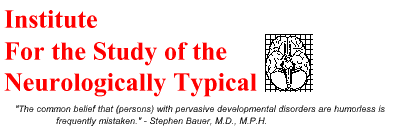Text Only
 D D
DSN-IV (The Diagnostic and Statistical Manual of 'Normal' Disorders)
Disorders Usually First Evident in Infancy, Childhood, or Adolescence
666.00 Neurotypic Disorder
The essential features constitute a severe form of Invasive Developmental Disorder,
with onset in infancy or childhood.
Diagnostic criteria for 666.00 Neurotypic Disorder
At least eight of the following sixteen items are present, these to include at least
two items from A, one from B, and one from C.
Note: Consider a criterion to be met only if the behavior is abnormal for the
person's developmental level.
- A. Qualitative impairment in independent social interaction as manifested by the
following:
- (The examples within parentheses are arranged so that those first mentioned
are more likely to apply to younger or more handicapped, and the later ones,
to older or less handicapped, persons with this disorder.)
-
(1) marked delusional sense of awareness of the existence or feelings of others (e.g., treats
a person as if he or she were an extention of himself; behaves as if clairavoyant of another
person's distress; apparently projects own concepts and needs onto others)
-
(2) extreme or abnormal seeking of comfort at times of distress (e.g., constantly
comes for comfort even when ill, hurt, or tired; seeks comfort in a stereotyped way, e.g., cries, whines needs demands for attention whenever hurt)
-
(3) constant or mindless imitation (e.g., always wave bye-bye; copies
mother's domestic activities; mechanical imitation of others' actions whenever
perceived to be in context)
-
(4) constant or excessive social play (e.g., always actively participates in simple
games; prefers group play activities; involves other children in play only
as long as the other children are exactly like themselves with no differences "mirrored images")
-
(5) gross impairment in ability to make peer friendships (e.g., obsessive interest in
making peer friendships with other Neurotypics; despite interest in making friends and afore mentioned
delusion of clairavoyance, demonstrates lack of understanding for those who are different and
an obsessive rigidity for social convention, for example, constantly seeks attention/positive
reinforment while staring mocking or laughing at others while they stim and rock and remain mute)
- B. Qualitative impairment in verbal and nonverbal communication, and in
imaginative activity, as manifested by the following:
- (The numbered items are arranged so that those first listed are more likely to
apply to younger or more handicapped, and the later ones, to older or less
handicapped, persons with this disorder.)
-
(1) blatent overuse of all modes of communication, such as communicative
babbling, facial expression, gesture, mime, or spoken language
-
(2) markedly abnormal nonverbal communication, as in the use of eye-to-
eye gaze, facial expression, body posture, or gestures to initiate or modulate social interaction (e.g., anticipates and enjoys being held, does not stiffens when
held, constantly looks at the other person or smiles when making a social approach,
compulsively greets parents or visitors,insists on invasively stares into the eyes of others
in social situations)
-
(3) excessive imaginative irrelevant activity, such as playacting of adult roles, fantasy
characters, or animals, lack of interest in computers or other logical fullfilling pastimes
-
(4) marked abnormalities in the production of speech, including volume,
pitch, stress, rate, rhythm, and intonation (e.g., gregarious grandious tone,
overly emotional or syrupy melody, or overcontrolled pitch)
-
(5) marked abnormalities in the form or content of speech, including stereotyped and repetitive use of speech (e.g., immediate mindless or mechanical repetition of NT peers' latest 'in' or catch phrases)
(e.g., "whatever" to mean "I am saying I disagree with you but I want you to be
upset by my saying so in this way"); idiosyncratic
use of words of phrases (e.g., "are you dissing me?" to mean "don't
disrespect me"); or frequent irrelevant remarks (e.g., starts talking about
the behavour of autistics at a table nearby during a meal at a restaurant)
-
(6) marked impairment in the ability to refrain from initiating a conversation or once
initated to sustain a full thought during conversation with others, despite adequate
speech (e.g., unable to stay ontopic/on thought due to the interjections from other Neurotypics)
- C. Markedly restricted repertoire of activities and interests, as manifested by the
following:
-
(1) inability or lack of understanding for or interest in stereotyped body
movements, e.g., hand-flicking or -twisting, spinning,
head-banging (except for during certain types of rock concerts),
complex whole-body movements
-
(2) persistent lack of awareness or inability to perceive parts of objects (e.g., seeing 'a windmill' but
failing to see the existance of the many beautiful finite parts which comprise the whole
object, oblivion to feelings of texture of materials, spinning wheels of toy
cars) or has an attachment to unusual objects (e.g., insists on driving around in a BMW, wearing
Rolex watches, carrying a cellular phone or briefcase)
-
(3) marked oblivion to changes in aspects of environment, e.g., when
a vase is moved from usual position
-
(4) unreasonable insistence in sameness in others in precise detail, e.g., insisting that exactly the same social behaviours always be followed when shopping
-
(5) markedly restricted range of interest and a preoccupation with one narrow interest, e.g., interested only in status quo climbing, impressing friends,
or in pretending to be smarter or better than they are.
- D. Onset during infancy or childhood.
-
Specify if childhood onset (after 36 months of age).
Author: Shelley from Kalamazoo
Return to the index page
Copyright � 1998 ISNT@autistics.org. Last updated December 5, 1998.
|

Qualitative impairment in independent social interaction as manifested by the
following... marked delusional sense of awareness of the existence or feelings of others (e.g., treats
a person as if he or she were an extention of himself; behaves as if clairavoyant of another
person's distress; apparently projects own concepts and needs onto others)
|
 D
D